If someone asked you to name the largest cities in China, what is likely to come to mind? Beijing, Guangzhou, and Shanghai, among other famous ones. Surprisingly, these super-developed cities do not make it to the list when ranked by land size.
The following eight cities are the largest by area:
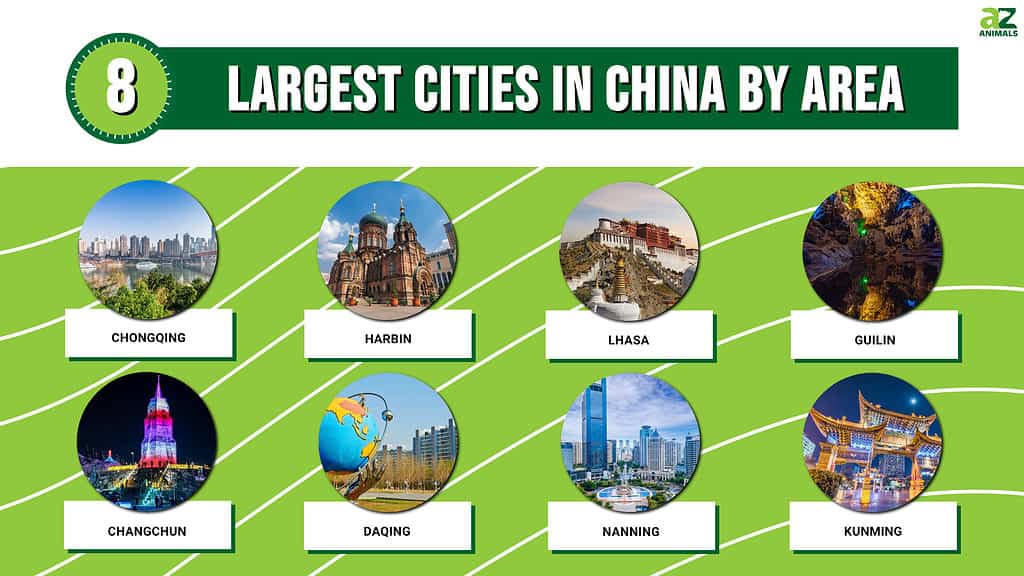
With a land size of 3.7 million square miles, China has more than 600 cities. It borders 14 countries by land and has a population of over 1.4 billion. The country consists of five autonomous regions, 22 provinces, two special administrative regions, and four municipalities.
If you plan to visit China, here are the eight largest cities you would love to explore.
1. Chongqing – 31,816 Square Miles
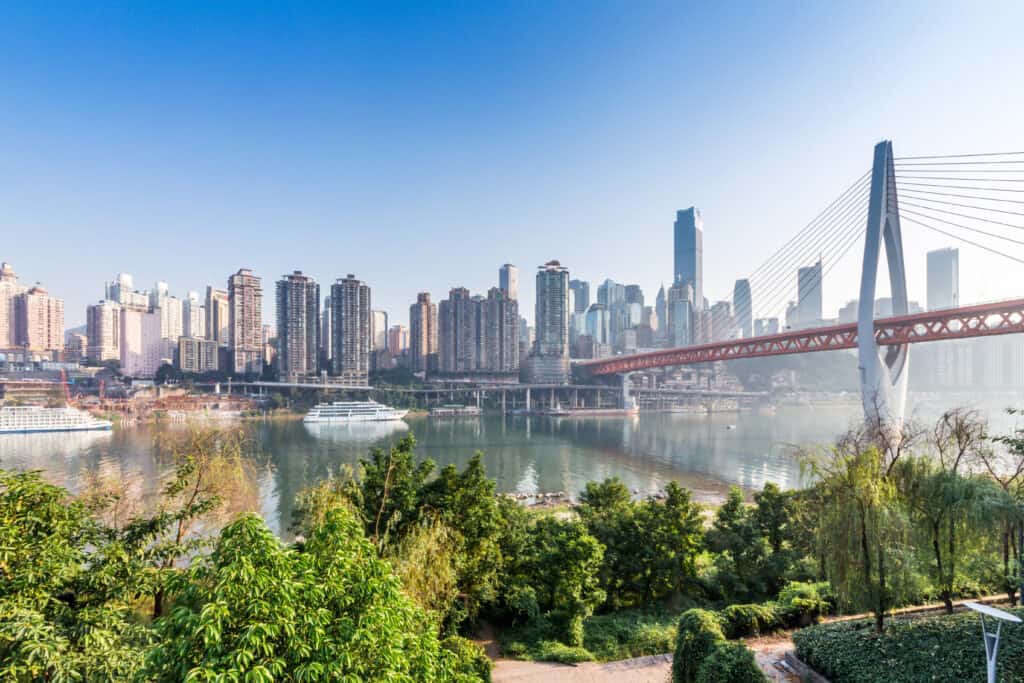
Chongqing is an alluring tourist spot thanks to its rich cultural heritage and abundant natural wonders.
©MyCreative/Shutterstock.com
Situated in southwest China, Chongqing is the country’s largest city in terms of land size. With a land area of 31,816 square miles, it is 51 times larger than London, 103 times bigger than New York, and 36 times more massive than Tokyo.
Chongqing was neither big nor famous until 1929, when the Chinese government promoted it to a municipality.
Since then, it has undergone gradual expansion and has 12 counties and 26 districts, making it the most extensive municipality in southwest China. This city is the most populous in China, with a population of 31.24 million.
The Mountain City, as it is commonly known, has wavy terrain with a wealth of mineral resources, water reserves, dense forests, and fantastic flora and fauna. Thanks to its rich cultural heritage and abundant natural wonders, the city is an alluring tourist destination. Tourists enjoy the downstream tour on the Yangtze River cruise to the magnificent Three Gorges.
Other major attractions in Chongqing include Chaotianmen Dock, Hongya Cave, Jiefangbei CBD, Ci Qi Kou Village, Wulong Karst, Chongqing Zoo, Dazu Rock Carvings, and People’s Assembly Hall.
Although Chongqing is not as bustling as Shanghai or Beijing, it has massive commercial centers for all your shopping needs and a lively nightlife.
2. Harbin – 20,502 Square Miles

Today, Harbin has unprecedented prosperity and an exotic cityscape, forming a key tour highlight.
©zhu difeng/Shutterstock.com
Harbin is the biggest provincial capital and the economic center in northeast China. Besides, it is Heilongjiang Province’s main center for transportation and the capital. It’s also the hub of the First Eurasia Railway.
The prosperity of the ‘Ice City,’ as Harbin is commonly known, can be attributed to its large size, massive tracts of arable land, and fertile black soil. It covers 20,502 square miles and has a population of 10.76 million.
Rice and corn farming and animal husbandry thrive in Harbin, thanks to its rich forest resource and good weather. It also produces a significant amount of coal and natural gas.
Exotic Russian buildings and snow scenery are the two essential tourist attractions in the city.
During winter, Harbin becomes an awesome ice city. Colorful lights then illuminate the scenic areas.
The city holds the annual Ice & Snow Festival, which attracts dozens of visitors, locally and abroad. They can experience skiing, skating, and snow carriages.
Today, Harbin has unprecedented prosperity and an exotic cityscape, forming a key tour highlight. It includes the St. Sophia Cathedral and the Dragon Tower.
3. Lhasa – 11,397 Square Miles
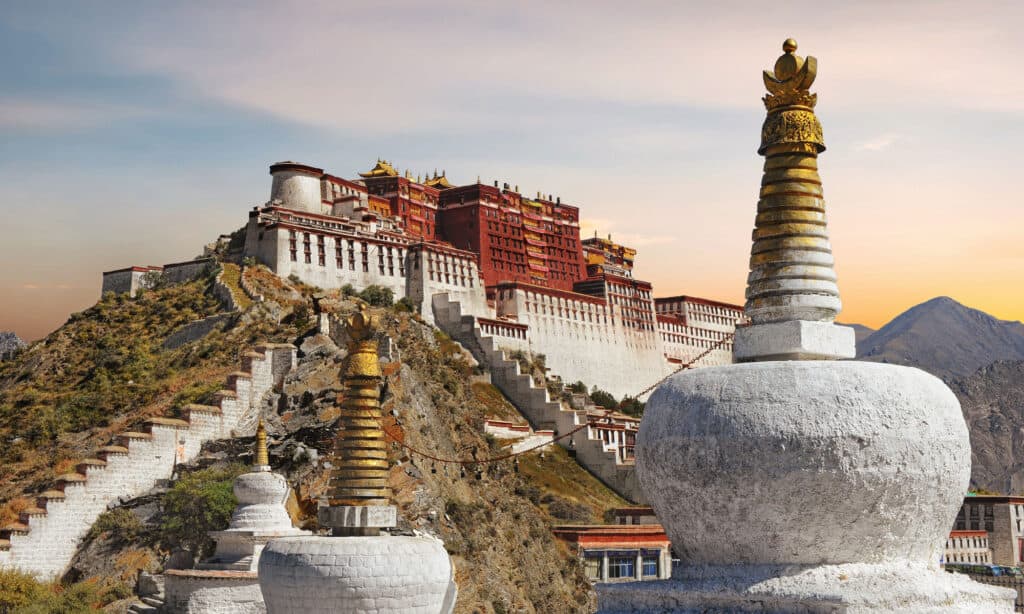
Lhasa is situated in a mountain-fringed valley on the north bank of
river
Kyichu on the Tibet plateau.
©iStock.com/Hung_Chung_Chih
Lhasa, the capital city of the Tibet Autonomous Region (TAR), is the third largest city in China by area. Its land size is 11,397 square miles, with a population of 558,900 people.
Many people refer to Lhasa as the City of Sunlight because it has an altitude of 11,975 feet and enjoys more than 3,000 hours of sunshine yearly.
The city has large alluvial plain areas on both sides of the Lhasa River. These areas are fertile and ideal for growing wheat and barley.
It also has a huge prairie, enabling locals to herd yaks and horses and make a living through husbandry.
Lhasa is situated in a mountain-fringed valley on the north bank of river Kyichu on the Tibet plateau. In the Tibetan language, Lhasa means the Buddha Land or the Holy Land.
Many believers set out for pilgrimages to this city all year round. There are more than 200 temples spread across the city.
Lhasa has high-rise businesses and all essential amenities like shopping malls, banks, and restaurants.
The city is a renowned tourist destination. It boasts tranquil grassland scenery, grand snow peaks and glaciers, beautiful plateau lakes, lush wetlands, and changeable geothermal clouds.
Lhasa was appointed among the 24 cultural and historical cities of China. The famous Potala Palace, which symbolizes the power of religion and politics, is situated here. Other attractions include the Sera Monastery, Jokhang Temple, Chakpori Hill, and Tibet Museum.
4. Guilin – 10,734 Square Miles
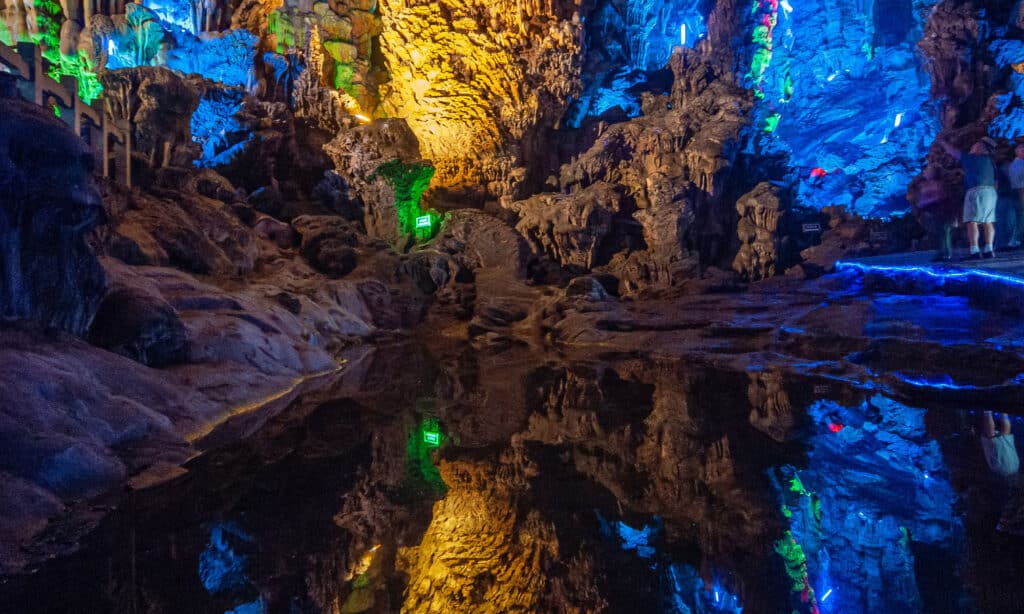
Guilin’s historical treasures and natural beauty make it the cradle of China’s tourism.
©iStock.com/ClaudineVM
Guilin is the fourth biggest city in China. It’s found in the northeast of Guangxi Zhuang. It boasts a land size of 10,734 square miles with a population of 5.4 million.
Guilin has a fantastic landscape and is considered the cradle of China’s tourism due to its historical treasures and natural beauty.
Most of its terrain features strangely shaped karsts, mysterious caves, grotesque rocks at the Li River, clear streams, and green mountains.
Forest cover accounts for more than 70% of the land area, with diverse vegetation ranging from conifers to bamboo. The city also oozes rich mineral resources such as marble, limestone, talc, granite, and fluorite.
Its top attractions include Longji Rice Terraces, Folded Brocade Hill, Two Rivers & Four Lakes, and Wave Subduing Hill.
As a modernized tourist city, Guilin has convenient means of transport like air, ship, train, bus, and taxis. There are plenty of shopping complexes and restaurants as well. In addition, tourists find the nightlife of this city fun and attractive.
5. Changchun – 9,522 Square Miles
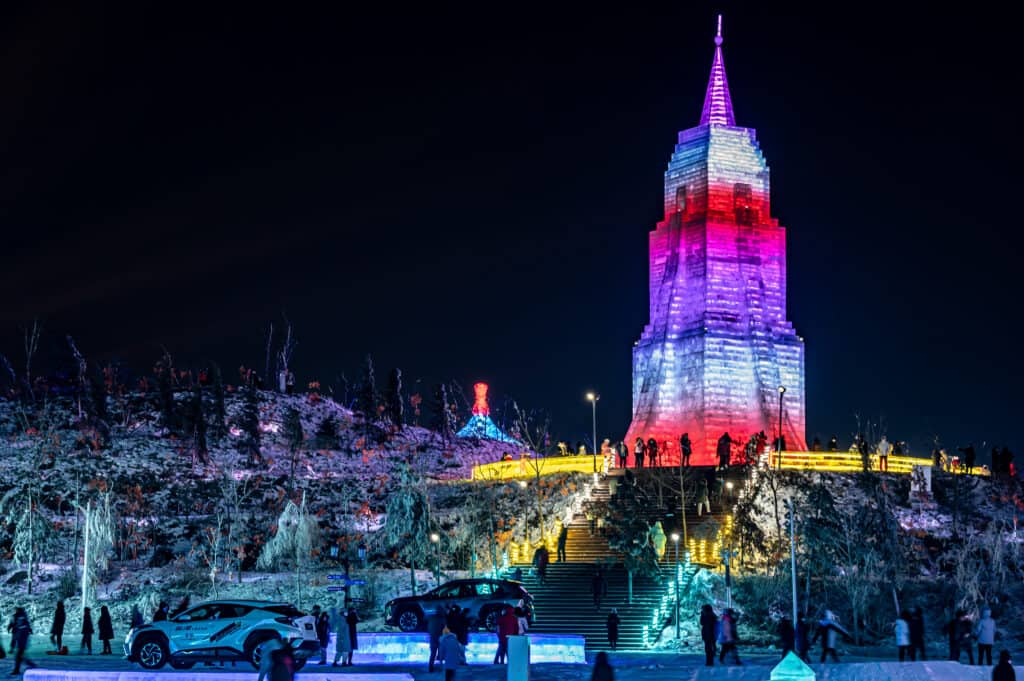
Changchun is one of the world’s leading automobile production and research bases.
©Xiao Wei/Shutterstock.com
Changchun is the fifth largest city in China by land size. Its vast terrain sits on 9,522 square miles with a population of 8.54 million.
Changchun is situated on the northeast China plain. It’s a crucial grain-growing region, producing considerable corn and rice.
Changchun is one of the world’s leading automobile production and research bases, with a strong foundation from the 1950s and 1960s.
The abundant coal resources in the city are one of the primary reasons why the Chinese government decided to set up a manufacturing base here.
This city was one of the first in China to access, dub, and produce films.
Besides, it is home to Changchun World Sculpture Park, which has a collection of more than 700 sculpture works worldwide.
Winter is special in Changchun as visitors see magnificent snow sceneries and participate in different snow sports and tourism festivals. The natural attractions lie in forests and lakes.
6. Daqing – 8,556 Square Miles

Daqing’s economy mainly depends on petroleum and petrochemical products.
©Dashu Xinganling/Shutterstock.com
Daqing city has a population of 2,781,562, according to the 2020 census. This vast city is located in northern China, in the Songnen plain, between Qiqihar and Harbin.
Daqing is home to Daqing Oilfield, the largest oil field in China and the world’s fourth largest. The field was discovered in the late 1950s, and drilling began in 1958.
At first, oil drilling was challenging since the area freezes during winter and has deep permafrost in the soil. But from the 1960s to the 1980s, large refineries were established in the city, raising oil production to significant proportions.
Daqing’s economy mainly depends on petroleum and petrochemical products. The city exports more than 10 million tons of crude oil every year.
There are lots of subsidiary chemical plants that use petroleum waste and by-products in this city. It links with neighboring cities primarily via road, air, and rail.
Besides the oilfield, there is a lot of farming, animal husbandry, forestry, and fishing in Daqing. These activities have aided the development of thriving textile and food processing industries.
You will find great colleges (like the Daqing Petroleum Institute), banking institutions, stadiums, shopping complexes, and entertainment hubs here.
7. Nanning – 8,537 Square Miles
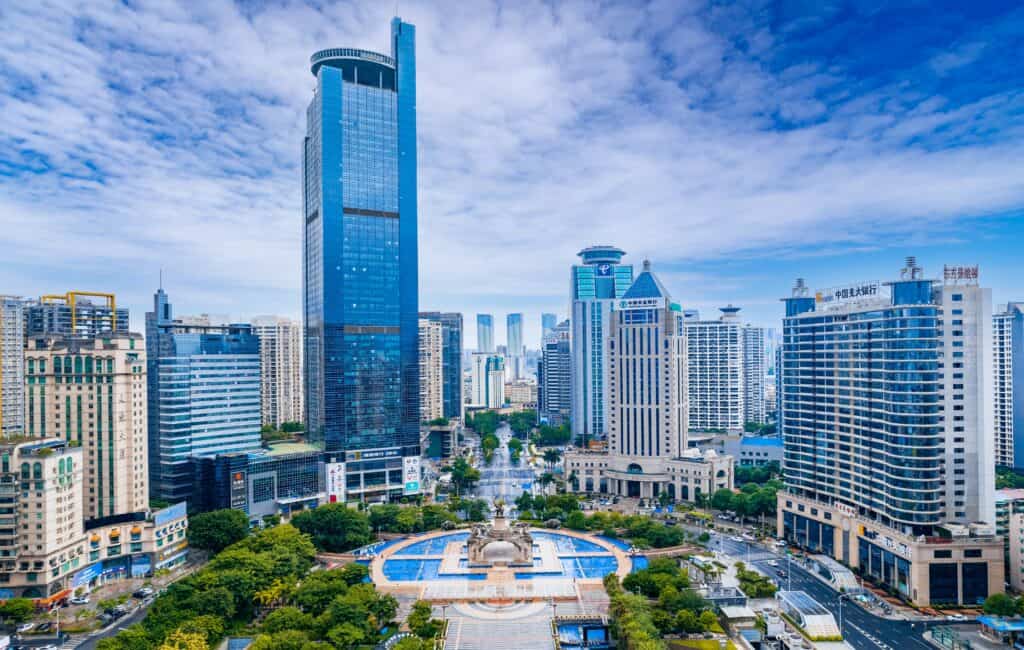
Nanning is Guangxi Province’s financial, economic, and cultural center.
©Weiming Xie/Shutterstock.com
Nanning is the seventh largest city in China and is home to 8.7 million people. The city is often called Green City as it has plenty of lush subtropical foliage.
Nanning is Guangxi Province’s financial, economic, and cultural center. Besides, it produces 33% of the country’s mineral resources, including gold, aluminum, silver, coal, manganese, and marble. Others are iron, granite, quartz, and indium.
There are plenty of museums, parks, historic sites, and mountains to visit in the city. They include the Anthropology Museum of Guangxi, Guangxi Art Museum, Nanning Museum, Yangmei Ancient Town, Nanning Wanda Amusement Park, and Diwang International Commerce Center.
There are also many high-end hotels in Nanning, including Golden Diamond Hotel, Mehood Lestie Hotel, and Yongjiang Hotel.
Besides, the vast assortment of street stalls and small eateries all over the city offer fresh, tasty, and affordable Chinese food.
8. Kunming- 8,291 Square Miles
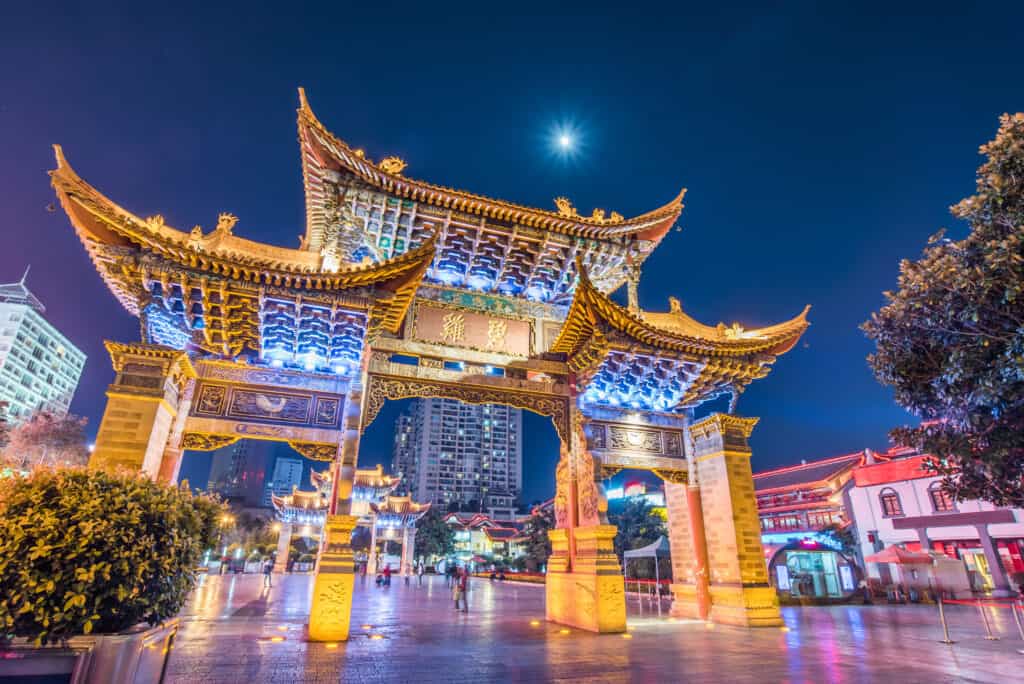
Kunming derives its economic significance from its geographical position.
©HelloRF Zcool/Shutterstock.com
Kunming is the capital of Yunnan Province. It is also the province’s economic, political, cultural, and communications center.
Many large businesses in Yunnan have their headquarters in Kunming. The city is home to 8.4 million people and consists of residential zones, modern commercial districts, and university areas.
Kunming derives its economic significance from its geographical position. It borders the southeastern Asian countries and serves as a transportation hub linking to Vietnam by rail and Thailand, Burma and Laos by road.
The city has numerous phosphorus and salt mines. Kunyang Phosphorus Mine is one of China’s three most significant phosphorus mines. Other minerals include magnesium, coal, silica, copper, clay, titanium, and quartz sand.
The top attraction spots in Kunming include the Bamboo Temple, the Golden Temple, Yunnan Provincial Museum, Yunnan Nationalities Museum, Baohai Park, and Dianchi Lake.
The entertainment district within Kunming is around Kundu Square. It has plenty of clubs, restaurants, bars, and cinemas.
Summary of the 8 Largest Cities in China by Area
| Rank by Area | City | Size |
|---|---|---|
| 1. | Chongqing | 31,816 Square Miles |
| 2. | Harbin | 20,502 Square Miles |
| 3. | Lhasa | 11,397 Square Miles |
| 4. | Guilin | 10,734 Square Miles |
| 5. | Changchun | 9,522 Square Miles |
| 6. | Daqing | 8,556 Square Miles |
| 7. | Nanning | 8,537 Square Miles |
| 8. | Kunming | 8,291 Square Miles |
The photo featured at the top of this post is © HelloRF Zcool/Shutterstock.com
Sources
- China, Available here: http://jilin.china.org.cn/2016-10/31/content_9123463.htm
- China Culture, Available here: http://en.chinaculture.org/focus/focus/cities/2010-05/27/content_380899.htm
- City Population, Available here: http://www.citypopulation.de/en/china/cities/
Thank you for reading! Have some feedback for us? Contact the AZ Animals editorial team.






